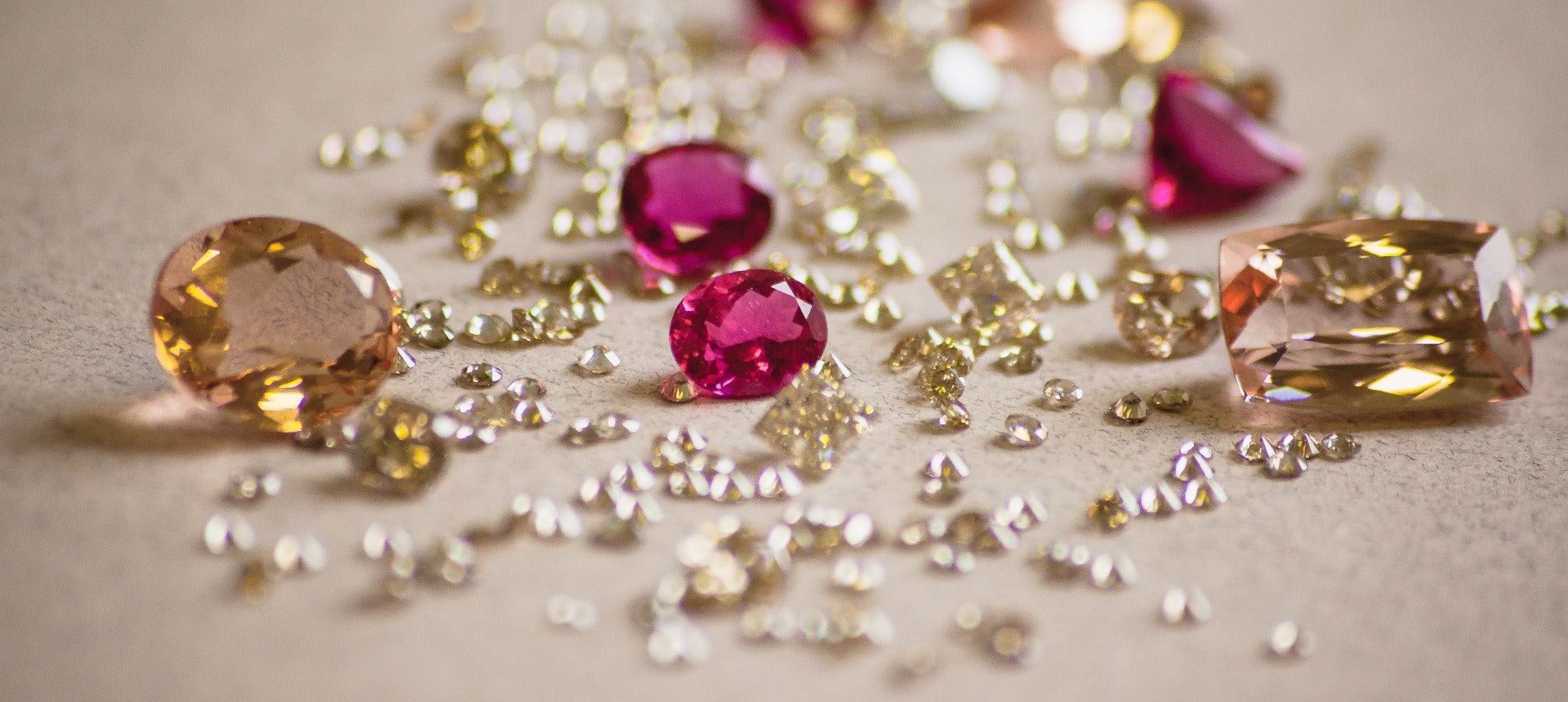Gem Cuts
Cutting gemstones is a process of turning rough, unpolished stones into gemstones as we know them, so they can be used in jewelry. Cutting gives the stones a specific shape and enables the true color and brilliance of the gem to emerge. Gem cutters generally need over two years of experience to be considered professionals, and it takes many factors to decide which cut would work best for a given rough stone to best hide its imperfections and to bring out its best qualities. Below are the many cuts and shapes that a cutter would be considering from in order to pass on the best value to his customer.
Gemstones may come in a variety of shapes, such as round, pear, square, octagon, oval, heart, and triangular, among many others. Each of these shapes may be fashioned into many different cuts, depending on the jeweler’s choice of exposing the gemstone’s many facets. For example, the square shape may be fashioned into a Princess cut, Radiant cut, Asscher cut and Cushion cut. Gemstone cuts differ in the amount and size of facets carved into the gem’s surface within each category.

Asscher
Alternatively called “Square Emerald cut”, it is a hybrid of a princess and an emerald cut. It presents with a distinct X in the gemstone’s table and features cropped corners along its four sides. Rather than creating a brilliant faceted pattern, which would bring out the gem’s fire, the “step-cut” facets in this cut maximize the gem’s clarity. This cut was developed by the Asscher brothers in 1902 of Holland and remained popular through the 1920’s. In 2001, the Asscher cut underwent some modifications by Edward and Joop Asscher, resulting in the Modern Asscher or Royal Asscher cut. The newer version increased the number of facets from 58 to 74, and introduced wider corners. The Asscher Cut resurfaced in popularity after appearing on Sex and the City. Since then, many celebrities began wearing Asscher cut engagement rings, such as Jessica Alba, Kate Hudson, Ashlee Simpson, Julia Roberts, Reese Witherspoon, and Gwyneth Paltrow.

Baguette
Long and rectangular in shape, baguette cut gemstones are a popular choice for accent stones in jewelry. The term Baguette originated from the Italian word “bacchetta”, meaning little stick; bacchio, meaning rod, or from the French word baguette, which is an oblong loaf a bread. The cut was created in the 1920-1930’s during the Art Deco and Art Nouveau movements. Because of its clean lines and a modern, geometric look, which deviated sharply from the traditional Round cut, it became instantly popular. Crafted in a “step cut” fashion, its 14 facets have been cut in steps along the edges, resembling a pyramid without its top. Although not as fiery and brilliant as a round cut, these stones are cut to maximize clarity. Since crafting Baguettes requires fewer cuts than other gemstone shapes, it is extremely important to cut them properly, since there are much fewer facets to hide any imperfections. Baguette cut stones can be regular or “tapered”, meaning two sides are tapered inward, resembling a trapezoid. The tapered variation works particularly well as side stones to a round centerpiece. Baguette cut stones usually run small in size, often less than one carat. Therefore, they are measured according to their dimensions, and not by carat weight. Their unique shape allows Baguette stones to be set side by side without gaps, unlike round stones, making them indispensable in today’s jewelry industry.

Briolette
The Briolette cut is a pear or drop-shaped stone with 84 triangular shaped facets covering its entire surface. There is no table, crown, or pavilion. Because of this, the Briolette is the most difficult shape to cut. In fact, a cutter can only cut about 5 to 10 briolettes per day. Although this cut does not burst with fire and brilliance like a modern Round Brilliant cut, but it does reflect light from all of its triangular facets. Its many angles, like tiny chandeliers, contribute to a wonderful display of color and radiance. Briolettes are a popular choice for dangling earrings, because as they dangle and move, they capture the most light. Briolettes usually are not mounted into heavy settings, and because of that, more of the gemstone is exposed to be visible. Most loose briolettes are drilled with a hole through the top, allowing jewelers to insert a hanging wire for earrings so the gem can dangle freely. Other times, a precious metal cap is secured onto the tip of the gemstone allowing the briolette to work as a pendant. The Briolette is believed to have originated in India as early as the 12th century, and then it may have spread to Europe with the famous French trader and traveler Jean-Baptiste Tavernier, who may have brought it with him from India. In fact, some maintain that the term Briolette comes from the French word “Brilliant”, meaning sparkling, and “Brignolette”, which translates into a “dried plum”. Once popular in the 17th century, before the emergence of more modern cuts such as Round Brilliant, many Briolettes were used in tiaras and crowns worn by monarchs, especially during the Victorian, Edwardian, and Art Deco time periods. In addition, Briolettes were a popular choice in earrings, pendants and necklaces of antique and estate jewelry of royalty and aristocrats.

Cabachon
A cabochon, alternatively known as “cab”, is simply a polished gemstone without any facets. It has a flat bottom and a slightly rounded top. The traditional Cabochon cut is oval in shape, but any shape can be cut Cabochon style. The term originates from the French “caboche”, meaning head. Gemstones shaped and polished “en cabochon” date back to early Judaic, Greek and Roman time periods. Cabochons surged in popularity in the late 13th – early 14th century in Europe, well before the advent of modern cutting technology and knowledge of faceting. In fact, this was the only gem fashioning available for a long time other than using gems in their natural crystal shape. Even though today most jewelers prefer faceted styles, certain gemstones are still cut “en cabochon”. Those are the ones where the gems’ special characteristics can only be seen when cut in cabochon. Some examples include asterism, or the star effect found in star sapphires and star rubies, chatoyancy, or the cat’s eye effect found in tourmaline, tiger’s eye, chrysoberyl and apatite, iridescence, or the changing of color in certain light or angle, such as an opal, or adularescence, or the milky-bluish luster or glow that emanates from inside the stone when held at a certain light, found in moonstone, rose quartz and agate. Other candidates for Cabochon cut include those that are naturally opaque or with limited transparency, such as turquoise, jade, and agate; those that possess great color but have some inclusions on their surface; or those that are not very durable. Since a Cabochon cut will minimize the appearance of scratches, many jewelers will opt to cut softer gemstones “en cabochon”, in order to prevent them from getting scratched in the faceting process.

(Antique) Cushion
Once referred to as “Old Mine Cut” or “Old European Cut”, this cut presents with approximately 64 facets and offers a basic square shape with gently rounded corners, making it look like a couch cushion. It may also be referred as a “Pillow Cut”. Just like a Princess cut, this cut maximizes utilizing the raw gem in the best way possible to avoid waste while simultaneously maintaining fabulous gem luster and brilliance. This traditional cut has been around for 200 years, and has been the industry standard before the start of 20th century. Some cushion cuts may appear slightly oval in their shape. In recent years, cushion cut has renewed its popularity, with Miley Cyrus, Jennifer Garner, Ivanka Trump, Giuliana Rancic, and Mena Suvari all sporting Cushion cut engagement rings.(Antique) Cushion Once referred to as “Old Mine Cut” or “Old European Cut”, this cut presents with approximately 64 facets and offers a basic square shape with gently rounded corners, making it look like a couch cushion. It may also be referred as a “Pillow Cut”. Some cushion cuts may appear slightly oval in their shape. In recent years, cushion cut has renewed its popularity, with Miley Cyrus, Jennifer Garner, Ivanka Trump, Giuliana Rancic, and Mena Suvari all sporting Cushion cut engagement rings.

Emerald
The Emerald Cut is shaped like a rectangle from the top, with trimmed corners. With approximately 50 facets, this particular cut presents with fewer facets than Round or Square cuts. The emphasis here is not so much on the sparkle, but on the gem’s clarity and color. Color tends to show very vividly in Emerald cut gemstones. In lighter colored gemstones, this cut can be quite dazzling with broader and more striking flashes of light, with the light bouncing between the light and dark surfaces of the gem, as if looking into a hall of mirrors. This cut was originally designed for cutting emeralds. Since emeralds occur in nature with numerous inclusions, cutting them is especially difficult due to potential chipping. The Emerald cut addressed those issues by decreasing the amount of force applied during cutting and protecting the stone from breakage. Eventually, this cut was used for diamonds and other gemstones as well. Customers were particularly drawn to this unique and stylish newer style, as its elongated shape looks particularly flattering on a finger. Beyonce, Mariah Carey, Angelina Jolie, Kate Hudson, Eva Longoria and Kim Kardashian were known to have worn Emerald cut engagement rings.

Heart
The heart shaped cut is in essence a pear shaped cut with a cleft at the top. With 59 standard facets, this cut can be very fiery and offer superb sparkle. Symmetry plays a vital role in selecting a good Heart Shaped cut gemstone. The two halves must be perfectly equal, and the cleft should be sharp and distinct and the sides should be slightly rounded. Rarely used as engagement rings, Heart Shaped gemstones remain a popular choice for earrings, pendants, and gemstone solitaire rings.

Marquise
This football shaped cut is also known as Navette Cut, and is crafted with 57 facets. It is a type of a modified brilliant cut, meaning it was cut to reflect the most light and offer maximum sparkle and color. It’s important to note that if a gem is cut too shallow, the light will pass through the back of the gem thereby reducing its color and sparkle. Striving for perfect symmetry is another important factor in crafting Marquise cut gemstones. The two end points must line up with each other precisely and the two halves of the stone should be perfect copies of each other. This will ensure that the stone sits properly in its setting, minimizing future chipping or breakage. The Marquise cut diamond was commissioned by King Louis XIV of France to present to his love, Marquise de Pompadour. With its long lines and elongated silhouette, it was supposed to resemble her perfectly shaped smile. Furthermore, its elongated shape flatters the finger, making it appear longer and slimmer. In recent years, the Marquise cut has even been set vertically. Catherine Zeta-Jones and Ashlee Simpson both received vertically set Marquise cut diamond engagement rings. Either way, due to its substantial surface area, this cut offers more weight per carat than any other cut and creates the illusion of a larger gemstone.

Octagon
This rectangular cut is another variation of utilizing a “step-cut” approach, where the stone is crafted with rows of wide, flat, concentric facets that resemble steps as if in a staircase along the gemstone’s circumference. The steps in this cut are not equidistant, unlike that of an Emerald cut. The usual number of facets in an Octagon cut is 53. Octagon cut gemstones are ideal in portraying any gemstone’s deep color. It also showcases any inclusions that a gem may have, so it’s important to look for gemstones that are particularly beautiful in color and are free from inclusions when considering the Octagon cut.

Oval
The Oval cut was created by Lazare Kaplan in the late 1950’s – early 1960’s. It presents with an elliptical shape when viewed from the top, and can be described as a hybrid between round and marquise shapes. Crafted with 69 facets, it is a type of a modified brilliant cut, which offers its wearer the brilliance and fire of a round cut gemstone, in a more unique shape. Its elongated silhouette is an added advantage, because it creates the illusion of a larger gemstone, and allows a finger to look longer and slimmer when wearing it. Famous Oval cut engagement rings include the stunning 12 carat oval sapphire ring Kate Middleton received from Prince William, which belonged to his late mother Princess Diana; and a 5 carat oval diamond ring that Katie Holmes received when she married Tom Cruise.

Pear
Fashioned in a shape of a gleaming teardrop, a Pear cut gemstone can be described as a hybrid between an Oval cut and a Marquise cut with a tapered point on one end. It is a type of a modified Round Brilliant cut and therefore offers 71 facets which reflect light beautifully and allow color to showcase dramatically. The first Pear cut diamond was crafted by a Flemish polisher Louis van Berquem of Belgium in 1458. When crafting a Pear cut gemstone, it is important to aim for perfect symmetry. The point should align with the peak of the rounded end. Pear cut gemstones require a special 6 prong setting, with a prong to maintain support for its fragile point. Most women wear the pointed end of the Pear cut gemstone in the direction of the fingernail, although that largely depends on the wearer’s choice. The elongated silhouette of a Pear cut ring lengthens and slims its wearer’s finger, making it an attractive choice not only for earrings and pendants, but for rings as well. Pear cut engagement rings were worn by such celebrities as Katherine Heigl, Avril Lavigne, Bethenny Frankel, and Jessica Simpson.
Looking For A Specific Cut?
If you are looking for a specific cut or need assistance selecting the right cut for your jewelry, please get in touch.

